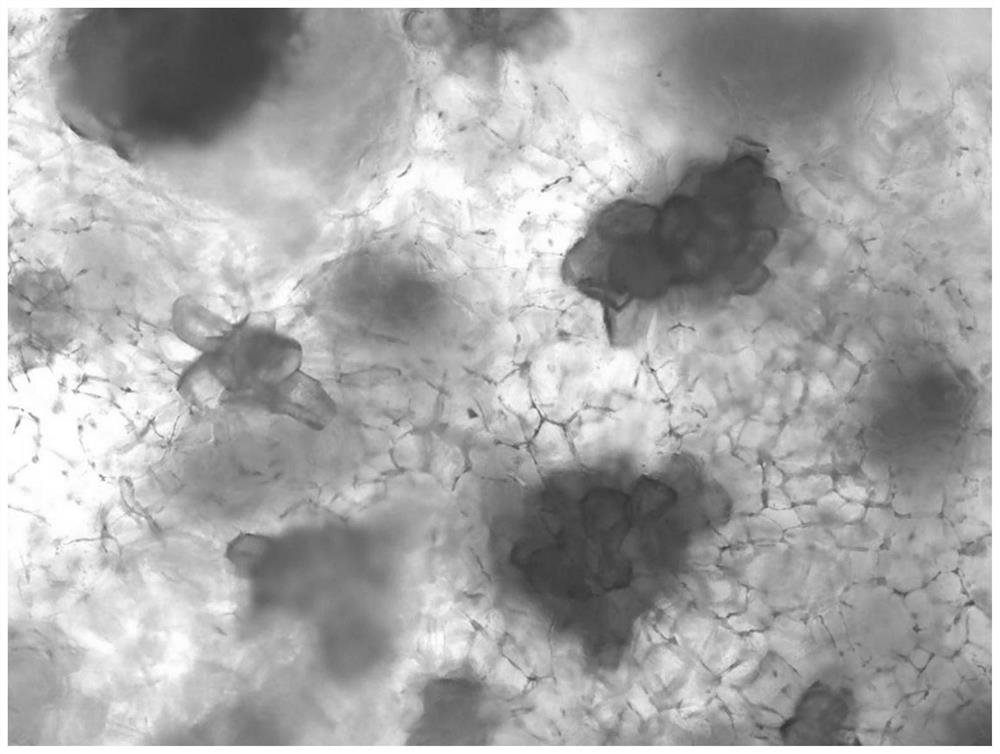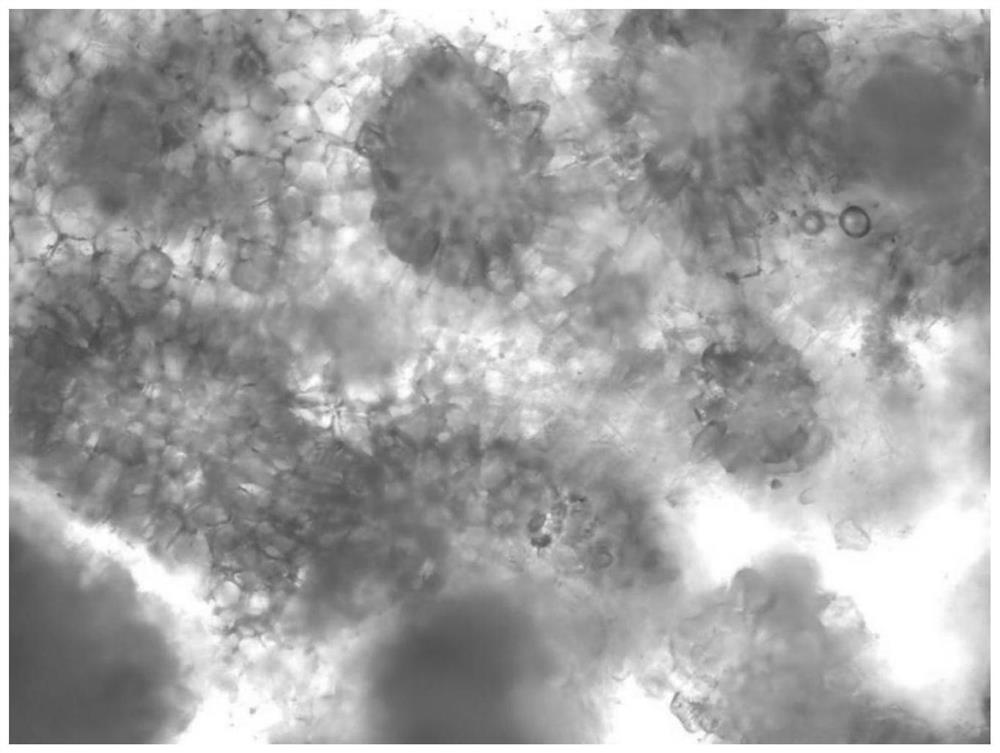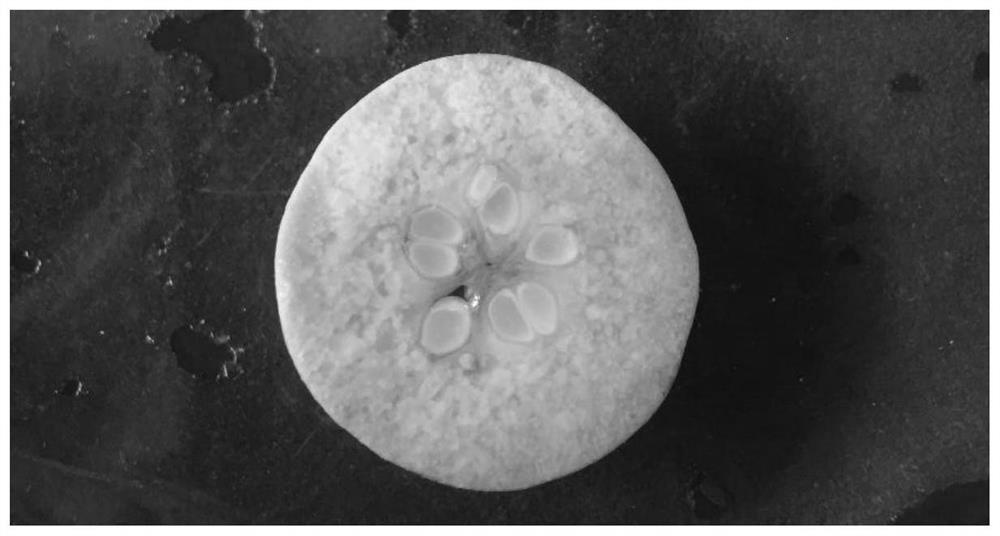Pear fruit stone cell specific histochemical localization method
A technique of histochemistry and pear fruit, applied in the field of cell staining, can solve the problems of accelerated browning of pear pulp, burnt skin, corroded skin, etc., and achieves the effects of high discrimination, sensitive response and easy operation.
- Summary
- Abstract
- Description
- Claims
- Application Information
AI Technical Summary
Problems solved by technology
Method used
Image
Examples
Embodiment 1
[0043] Diaminobenzidine-specific histochemical localization of stone cells
[0044] The pear fruit is placed in the vitamin C solution of 0.05g / L and sliced (the thickness of the section is 3cm), then the pear fruit slice is submerged in the diaminobenzidine solution with a concentration of 0.5g / L, and transferred to the light incubator Soak in dark and culture for 4 hours (reagents are easy to decompose when exposed to light), adjust the temperature to 24°C, decolorize and rinse with decolorizing agent, seal the slide with FAA fixative solution and observe under ordinary optical microscope. The staining results are as follows: figure 1 shown. Wherein the decolorizing agent is glycerin solution and ethanol solution, the volume ratio of glycerol solution and ethanol solution is 1:1, the volume percentage content of glycerin solution is 30%, and the volume percentage content of ethanol solution is 70%.
[0045] from figure 1 It can be seen that all the stone cells are dyed r...
Embodiment 2
[0047] Nitrotetrazolium-stone cell-specific histochemical localization
[0048] Pear fruit is placed in 0.05g / L vitamin C solution and sliced (the thickness of the slice is 3cm), then the pear fruit slice is submerged in the nitrotetrazole solution with a concentration of 0.5g / L, and transferred to light culture Soak in the box and cultivate in the dark for 4 hours (the reagent is easy to decompose when exposed to light), the temperature is adjusted to 24°C, the decolorizing agent is decolorized and rinsed, and the slide is sealed with FAA fixative solution for observation. The staining results are as follows: figure 2shown. Wherein the decolorizing agent is glycerin solution and ethanol solution, the volume ratio of glycerol solution and ethanol solution is 1:1, the volume percentage content of glycerin solution is 30%, and the volume percentage content of ethanol solution is 70%.
[0049] from figure 2 It can be seen that the stone cells are stained blue-gray, and the ...
Embodiment 3
[0051] Comparison of specific histochemical localization of pear stone cells in Dangshansu pear and Liangli Zaosu
[0052] Put the Dangshansu pear fruit and Liangli Zaosu fruit in 0.05g / L vitamin C solution to slice (3cm), and then submerge the pear fruit slices in 0.5g / L diaminobenzidine solution and nitric acid solution respectively. In the tetrazolium-based solution, transfer to the light incubator and soak in the dark for 4 hours (the reagent is easy to decompose when exposed to light), the temperature is adjusted to 24°C, the decolorizing agent is decolorized and rinsed, and the slide is sealed with FAA fixative solution for observation. The staining results are as follows: Figure 3-2 with Figure 3-3 shown. Wherein the decolorizing agent is glycerin solution and ethanol solution, the volume ratio of glycerol solution and ethanol solution is 1:1, the volume percentage content of glycerin solution is 30%, and the volume percentage content of ethanol solution is 70%.
[...
PUM
| Property | Measurement | Unit |
|---|---|---|
| Concentration | aaaaa | aaaaa |
| Thickness | aaaaa | aaaaa |
Abstract
Description
Claims
Application Information
 Login to View More
Login to View More - R&D Engineer
- R&D Manager
- IP Professional
- Industry Leading Data Capabilities
- Powerful AI technology
- Patent DNA Extraction
Browse by: Latest US Patents, China's latest patents, Technical Efficacy Thesaurus, Application Domain, Technology Topic, Popular Technical Reports.
© 2024 PatSnap. All rights reserved.Legal|Privacy policy|Modern Slavery Act Transparency Statement|Sitemap|About US| Contact US: help@patsnap.com










